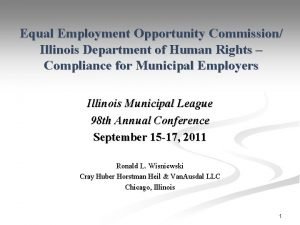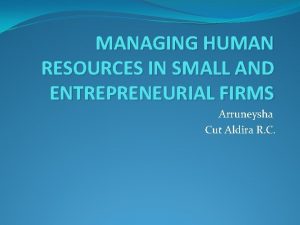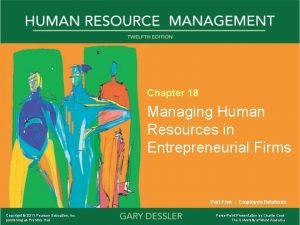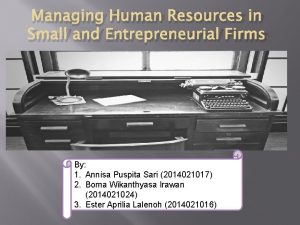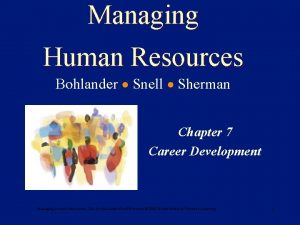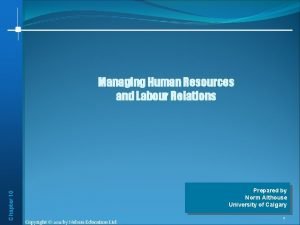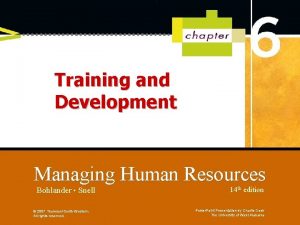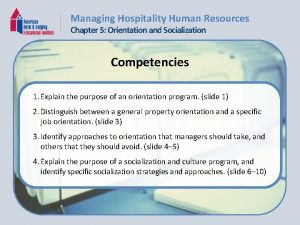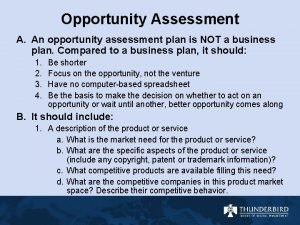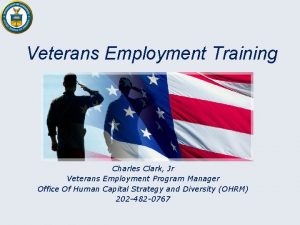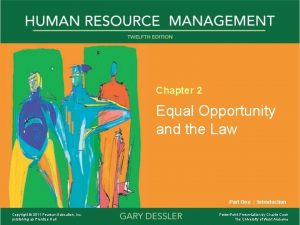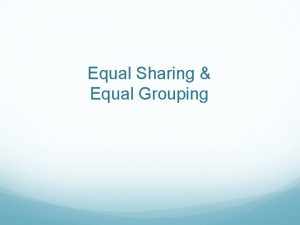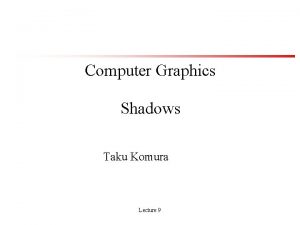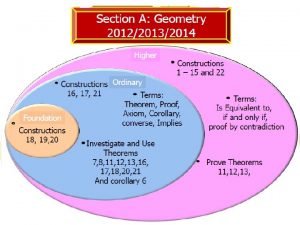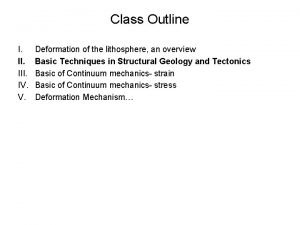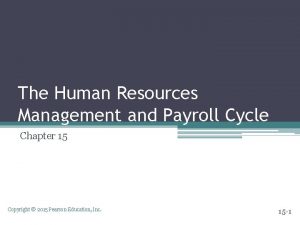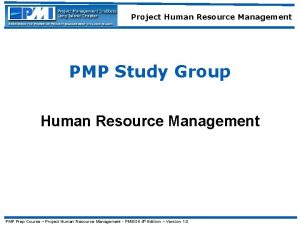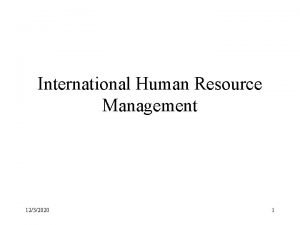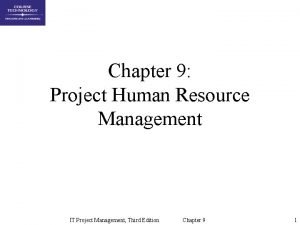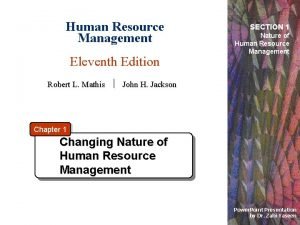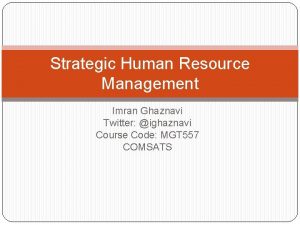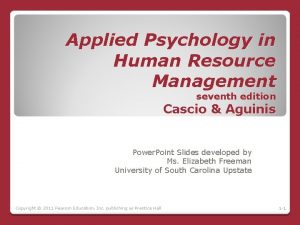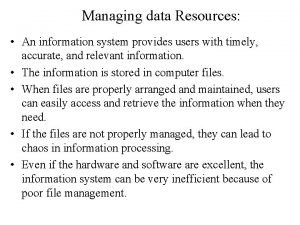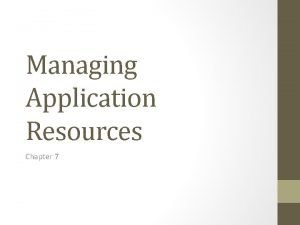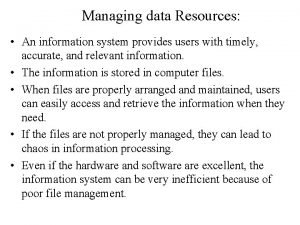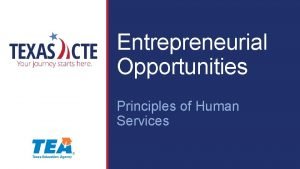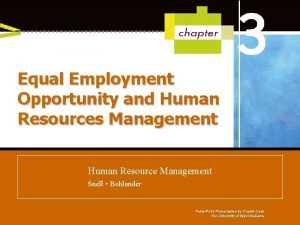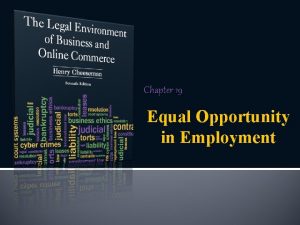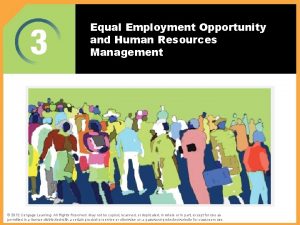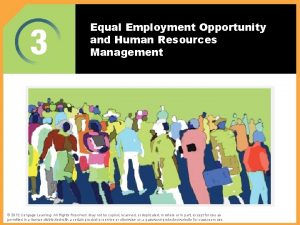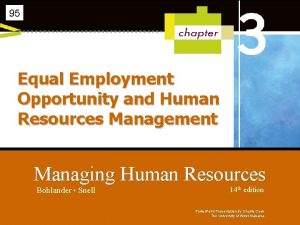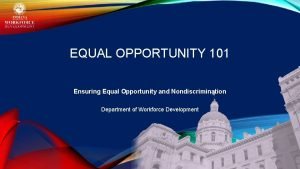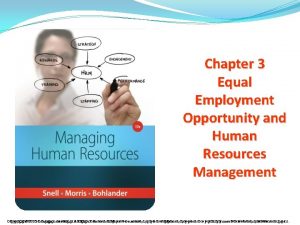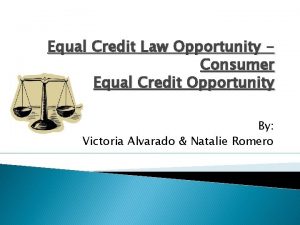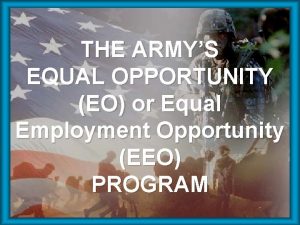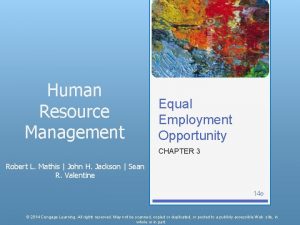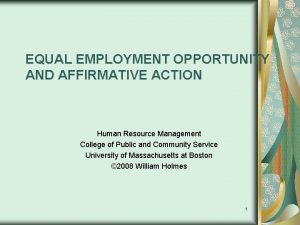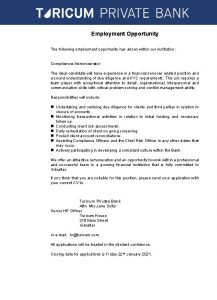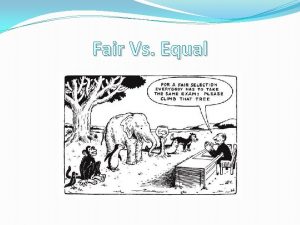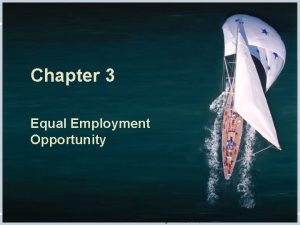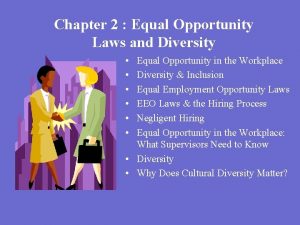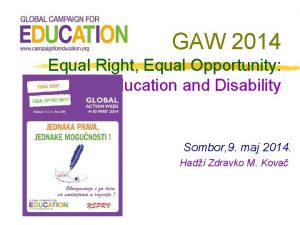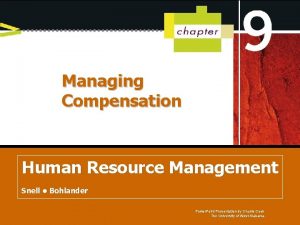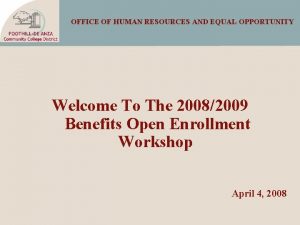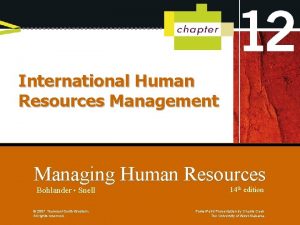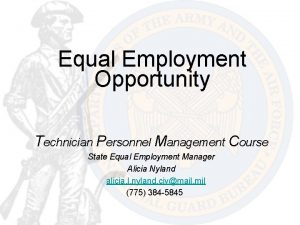Equal Employment Opportunity and Human Resources Management Managing













































- Slides: 45

Equal Employment Opportunity and Human Resources Management Managing Human Resources Bohlander • Snell 14 th edition Power. Point Presentation by Charlie Cook The University of West Alabama

Objectives After studying this chapter, you should be able to: 1. Explain the reasons behind passage of EEO legislation. 2. Prepare an outline describing the major laws affecting equal employment opportunity. Describe bona fide occupational qualification and religious preference as EEO issues. 3. Discuss sexual harassment and immigration reform and control as EEO concerns. 4. Explain the use of the Uniform Guidelines on Employee Selection Procedures. © 2007 Thomson/South-Western. All rights reserved. 2

Objectives (cont’d) After studying this chapter, you should be able to: 5. Provide examples illustrating the concept of adverse impact and apply the four-fifths rule. 6. Discuss significant court cases affecting equal employment opportunity. 7. Illustrate the various enforcement procedures affecting equal employment opportunity. 8. Describe affirmative action and the basic steps in developing an affirmative action program. © 2007 Thomson/South-Western. All rights reserved. 3

Historical Perspective of EEO Legislation • Equal Employment Opportunity (EEO) Ø The treatment of individuals in all aspects of employment—hiring, promotion, training, etc. —in a fair and nonbiased manner. • Changing National Values • Economic Disparity • Early Legal Developments Ø Civil Rights Act (1866) Ø Executive Order 8802 Ø Civil Rights Act (1964) © 2007 Thomson/South-Western. All rights reserved. 4

Government Regulation of EEO • Protected Classes Ø Individuals of a minority race, women, older people, and those with disabilities who are covered by federal laws on equal employment opportunity. © 2007 Thomson/South-Western. All rights reserved. 5

Major Laws Affecting Equal Employment Opportunity © 2007 Thomson/South-Western. All rights reserved. 6

Major Laws Affecting Equal Employment Opportunity (cont’d) © 2007 Thomson/South-Western. All rights reserved. 7

Major Laws Affecting Equal Employment Opportunity (cont’d) © 2007 Thomson/South-Western. All rights reserved. 8

Section 703(a) of Title VII of the Civil Rights Act • It shall be unlawful employment practice for an employer: To fail or refuse to hire or to discharge any individual, or otherwise to discriminate against any individual with respect to his [or her] compensation, terms, conditions, or privileges of employment because of such individual’s race, color, religion, sex, or national origin. . © 2007 Thomson/South-Western. All rights reserved. 9

Jurisdiction of the Civil Rights Act of 1964 • All private employers in interstate commerce who employ fifteen or more employees for twenty or more weeks per year • State and local governments • Private and public employment agencies, including the U. S. Employment Service • Joint labor-management committees that govern apprenticeship or training programs • Labor unions having fifteen or more members or employees • Public and private educational institutions • Foreign subsidiaries of U. S. organizations employing U. S. citizens © 2007 Thomson/South-Western. All rights reserved. 10

Exemptions From Antidiscrimination Regulations • Bona Fide Occupational Qualification (BFOQ) Ø Suitable defense against a discrimination charge only where age, religion, sex, or national origin is an actual qualification for performing the job. • Business Necessity Ø Work-related practice that is necessary to the safe and efficient operation of an organization. © 2007 Thomson/South-Western. All rights reserved. 11

Age Discrimination Actions • Excluding older workers from important work activities. • Making negative changes in the performance evaluations of older employees. • Denying older employees job-related education, career development, or promotional opportunities. • Selecting younger job applicants over older, betterqualified candidates. • Pressuring older employees into taking early retirement. • Reducing the job duties and responsibilities of older employees. • Terminating older employees through downsizing. © 2007 Thomson/South-Western. All rights reserved. 12

What Is a “Disability”? • The Americans With Disabilities Act defines a disability as: Ø A physical or mental impairment that substantially limits one or more of the major life activities. Ø A record of such impairment. Ø Being regarded as having such an impairment. © 2007 Thomson/South-Western. All rights reserved. 13

What Is a “Disability”? (cont’d) • The ADA does not cover: 1. Homosexuality or bisexuality 2. Gender-identity disorders not resulting from physical impairment or other sexual-behavior disorders 3. Compulsive gambling, kleptomania, or pyromania 4. Psychoactive substance-use disorders resulting from current illegal use of drugs 5. Current illegal use of drugs 6. Infectious or communicable diseases of public health significance (applied to food-handling jobs only and excluding AIDS) © 2007 Thomson/South-Western. All rights reserved. 14

EEO Rules Applicable to Federal Contractors and Agencies © 2007 Thomson/South-Western. All rights reserved. 15

Fair Employment Practice Laws • Fair Employment Practices (FEPs) Ø State and local laws governing equal employment opportunity that are often more comprehensive than federal laws. Ø Although Title VII of the Civil Rights Act exempts employers with fewer than fifteen employees, many states extend antidiscrimination laws to smaller employers with one or more workers. © 2007 Thomson/South-Western. All rights reserved. 16

Sexual Harassment • Sexual Harassment (under Title VII) Ø Unwelcome advances, requests for sexual favors, and other verbal or physical conduct of a sexual nature in the working environment Ø An employer is considered guilty of sexual harassment when: v The employer knew or should have known about the unlawful conduct and failed to remedy it or to take corrective action. v The employer allows non-employees (customers or salespeople) to sexually harass employees. © 2007 Thomson/South-Western. All rights reserved. 17

Sexual Harassment Unwelcome advances, requests for sexual favors, and other verbal or physical conduct of a sexual nature in the working environment. Types of Sexual Harassment Quid Pro Quo Submission Rejection © 2007 Thomson/South-Western. All rights reserved. Hostile Environment Uncomfortable Subjective Response 18

Sexual Harassment • Quid Pro Quo Harassment Ø Occurs when “submission to or rejection of sexual conduct is used as a basis for employment decisions. ” Ø Involves a tangible or economic consequence, such as a demotion or loss of pay. Ø Oncale v Sundowner Offshore Services (1998) v Same-sex sexual harassment (male-to-male, female-to-female) is covered under Title VII. © 2007 Thomson/South-Western. All rights reserved. 19

Sexual Harassment (cont’d) • Hostile Environment Ø Occurs when unwelcome sexual conduct “has the purpose or effect of unreasonably interfering with job performance or creating an intimidating, hostile, or offensive working environment. ” Ø Dirty jokes, vulgar slang, nude pictures, swearing, and personal ridicule and insult constitute sexual harassment when an employee finds them offensive. Ø Courts use a “reasonable person” test for hostile environment. © 2007 Thomson/South-Western. All rights reserved. 20

Sexual Orientation • Title VII of the Civil Rights Act of 1964 lists “sex” (gender) as a protected class. Ø Court cases have consistently held that sexual orientation is not a valid defense against discrimination. Ø No federal law bars discrimination based on one’s sexual orientation. Ø Companies—in support of their diversity initiatives— increasingly are fostering “gay-friendly” work places. Ø Of the nation’s top 500 companies, 70 percent now offer health benefits to same-sex couples. © 2007 Thomson/South-Western. All rights reserved. 21

Immigration Reform and Control Act (1986) • Employers must comply with the Act by: 1. Having employees fill out their part of Form I-9. 2. Checking documents establishing an employee’s identity and eligibility to work. 3. Complete the employer’s section of Form I-9. 4. Retain Form I-9 for at least three years. 5. Present Form I-9 for inspection to an Immigration and Naturalization Service officer or to a Department of Labor officer upon request. © 2007 Thomson/South-Western. All rights reserved. 22

Uniform Guidelines on Employee Selection Procedures • Uniform Guidelines on Employee Selection Procedures Ø A procedural document published in the Federal Register to assist employers in complying with federal regulations against discriminatory actions. Ø Applies to employee selection procedures in the areas of hiring, retention, promotion, transfer, demotion, dismissal, and referral. © 2007 Thomson/South-Western. All rights reserved. 23

Uniform Guidelines on Employee Selection Procedures • Uniform Guidelines on Employee Selection Procedures define discrimination as: Ø The use of any selection procedure which has an adverse impact on the hiring, promotion, or other employment or membership opportunities of members of any race, sex, or ethnic group (protected class) will be considered to be discriminatory and inconsistent with these guidelines, unless the procedure has been validated in accordance with these guidelines (or, certain other provisions are satisfied). © 2007 Thomson/South-Western. All rights reserved. 24

Validity • The requirement that, when using a test or other selection instrument to choose individuals for employment, employers must be able to prove that the selection instrument bears a direct relationship to job success. • Proof of validity is established through validation studies that show the job relatedness or lack thereof for the selection instrument under study. © 2007 Thomson/South-Western. All rights reserved. 25

Forms of Discrimination • Adverse Impact Ø The rejection of a significantly higher percentage of a protected class for employment, placement, or promotion when compared with the successful, nonprotected class. Ø Possibly the unintentional result of an innocent act, yet the outcome is still discriminatory. • Disparate Treatment Ø An employer’s intentional unequal treatment or evaluation by different standards of protected-class members. © 2007 Thomson/South-Western. All rights reserved. 26

Determining Discrimination • Adverse Rejection Rate, or Four-Fifths Rule Ø Rule of thumb followed by the EEOC in determining adverse impact for use in enforcement proceedings. v According to the Uniform Guidelines, a selection program has an adverse impact when the selection rate for any racial, ethnic, or sex class is less than four-fifths (or 80 percent) of the rate of the class with the highest selection rate. Ø The four-fifths rule is not a legal definition of discrimination, rather it is used to monitor severe discrimination practices. © 2007 Thomson/South-Western. All rights reserved. 27

Determining Discrimination • Mc. Donnell Douglas Test Ø Establish a Prima Facie Case of Discrimination: 1. The person is a member of a protected class. 2. The person applied for a job for which he or she was qualified. 3. The person was rejected, despite being qualified. 4. After rejection, the employer continued to seek other applicants with similar qualifications. Ø The burden now shifts to the employer to prove that the action taken against the individual was not discriminatory. © 2007 Thomson/South-Western. All rights reserved. 28

Determining Adverse Impact: The Four-fifths Rule Source: Adoption of Questions and Answers to Clarify and Provide a Common Interpretation of the Uniform Guidelines on Employee Selection Procedures, Federal Register 44, no. 43 (March 2, 1979): 11998. © 2007 Thomson/South-Western. All rights reserved. 29

Determining Adverse Impact The Four-Fifths Rule A rule of thumb followed by the EEOC in determining adverse impact for use in enforcement proceedings. © 2007 Thomson/South-Western. All rights reserved. 30

Workforce Utilization Analysis • Workforce Utilization Analysis Ø The process of comparing the composition by race and sex for jobs within an organization against composition of the employer’s relevant labor market. Ø The workforce is at parity when its composition matches the relevant labor market. Ø If the workforce composition is below external figures, the affected protected classes are underutilized and the employer should take affirmative steps to correct the imbalance. © 2007 Thomson/South-Western. All rights reserved. 31

Significant Court Cases • Griggs v Duke Power Company (1971) Ø The Supreme Court ruled that employer discrimination need not be overt or intentional to be present— employment practices having an adverse impact on protected classes can be illegal even when applied equally to all employees. Ø Employers have the burden of proving that employment requirements are job-related or constitute a business necessity and are absolutely necessary for job success. Ø Good intent, or absence of intent to discriminate, is not a sufficient defense of adverse impact. © 2007 Thomson/South-Western. All rights reserved. 32

Significant Court Cases (cont’d) • Albemarle Paper Company v Moody (1975) Ø Supreme Court strengthened requirements on employers to demonstrate that tests used in hiring or promotion decisions are job-related and valid predictors of job success. © 2007 Thomson/South-Western. All rights reserved. 33

The Equal Employment Opportunity Commission (EEOC) • Composition of EEOC Ø Five members and a general counsel appointed by the president and confirmed by the Senate Ø Members serve staggered five-year terms Ø No more than three commission members from the same political party. Ø General counsel serves a four-year term. • Purpose of EEOC Ø Formulating EEO policy and approving all litigation involved in maintaining equal employment opportunity. © 2007 Thomson/South-Western. All rights reserved. 34

Figure 3– 5 Filing a Charge of Employment Discrimination © 2007 Thomson/South-Western. All rights reserved. 35

Internal Discrimination Complaint Procedure Employee discrimination charge Organizational EEO officer or designated HR staff person Reported to manager or supervisor Investigation No basis for charge: charge dismissed Decision on charge Charge upheld Accused: Oral or written reprimand Suspension Discharge Harmed Employee: Appeal to organizational EEO grievance committee © 2007 Thomson/South-Western. All rights reserved. Restore all lost employment conditions 36

How to Achieve Fairness in EEO 1. Correct stereotyped thinking. 2. Eliminate irrelevant job requirements. 3. Open job and promotion opportunities to all protected classes. 4. Promote on the basis of merit rather than seniority. 5. Provide equal pay for equal work. 6. Modify employee benefits to needs of women, minorities, and working families. 7. Management training in EEO requirements. © 2007 Thomson/South-Western. All rights reserved. 37

Affirmative Action Issues • Affirmative Action Ø Policy that goes beyond equal employment opportunity by requiring organizations to comply with the law and correct past discriminatory practices by increasing the numbers of minorities and women in specific positions. • Reverse Discrimination Ø The act of giving preference to members of protected classes to the extent that unprotected individuals believe they are suffering discrimination. © 2007 Thomson/South-Western. All rights reserved. 38

Affirmative Action Court Cases • University of California Regents v Bakke (1978) Ø The Supreme Court ruled that: Applicants must be evaluated on an individual basis. v Race can be one factor used in the evaluation process as long as other competitive factors are considered. v Ø The Court stated that affirmative action programs were not illegal (reverse discrimination) per se as long as rigid quota systems were not specified for different protected classes. © 2007 Thomson/South-Western. All rights reserved. 39

Affirmative Action Court Cases (cont’d) • United Steelworkers of America v Weber (1974) Ø The Supreme Court held that voluntary affirmative action programs are permissible where they attempt to eliminate racial imbalances in “traditionally segregated job categories. ” Ø In Weber, the Court did not endorse all voluntary affirmative action programs. © 2007 Thomson/South-Western. All rights reserved. 40

Managing Diversity: Affirmative Action • Challenges to Affirmative Action (AA): Ø AA has not improved protected groups employment. Ø Individuals hired under AA feel prejudged as inferior performers, and are often viewed as “tokens. ” Ø AA programs have failed in assimilating protected classes into the workforce. Ø Preferences shown toward one protected class may create conflicts between other minority groups. © 2007 Thomson/South-Western. All rights reserved. 41

Highlights in HRM 6 Basic Steps in Developing an Effective Affirmative Action Program 1. Issue a written equal employment opportunity policy and affirmative action commitment. 2. Appoint a top official with responsibility and authority to direct and implement the program. 3. Publicize the policy and affirmative action commitment. 4. Survey present minority and female employment by department and job classification. 5. Develop goals and timetables to improve utilization of minorities and women in each area where underutilization has been identified. 6. Develop and implement specific programs to achieve goals. 7. Establish an internal audit and reporting system to monitor and evaluate progress in each aspect of the program. 8. Develop supportive in-house and community programs. © 2007 Thomson/South-Western. All rights reserved. 42

Court Decisions on Affirmative Action • Adarand Constructors v Peña (1995) Ø The Supreme Court ruled that federal programs that use race or ethnicity as a basis for decision making must be strictly scrutinized to ensure that they promote “compelling” governmental interests. • Hopwood v State of Texas (1996) Ø The Court ruled in a decision affecting admission standards at the University of Texas law school that diversity could not constitute a compelling state interest justifying racial preference in selection decisions. © 2007 Thomson/South-Western. All rights reserved. 43

Managing Diversity: Affirmative Action • Grutter v Bollinger Ø The Supreme Court held in that colleges and universities can consider an applicant’s race as a factor in admission decisions. Ø The decision upheld an admission policy at the University of Michigan Law School in which officials considered an applicant’s race along with other factors when making admission decisions. © 2007 Thomson/South-Western. All rights reserved. 44

Key Terms • adverse impact • affirmative action • bona fide occupational qualification (BFOQ) • fair employment practices (FEPs) • four-fifths rule • protected classes • business necessity • reasonable accommodation • charge form • reverse discrimination • disabled individual • sexual harassment • disparate treatment • Uniform Guidelines on Employee Selection Procedures • EEO-1 report • equal employment opportunity © 2007 Thomson/South-Western. All rights reserved. • workforce utilization analysis 45
 Equal opportunity illinois
Equal opportunity illinois Managing human resources in small and entrepreneurial firms
Managing human resources in small and entrepreneurial firms Employee selection
Employee selection Managing human resources in small and entrepreneurial firms
Managing human resources in small and entrepreneurial firms Managing global human resources
Managing global human resources Managing human resources snell
Managing human resources snell Chapter 10 managing human resources
Chapter 10 managing human resources Managing human resources bohlander
Managing human resources bohlander Managing hospitality human resources
Managing hospitality human resources Managing global human resources
Managing global human resources An opportunity assessment plan is
An opportunity assessment plan is Veteran employment opportunity act
Veteran employment opportunity act Equal opportunity and the law chapter 2
Equal opportunity and the law chapter 2 Difference between equal sharing and equal grouping
Difference between equal sharing and equal grouping Equal opportunity fund
Equal opportunity fund Equal height equal light
Equal height equal light Taku graphics
Taku graphics Vertically opposite angle
Vertically opposite angle Equal area vs equal angle stereonet
Equal area vs equal angle stereonet Sweden and norway use equal quantities of resources
Sweden and norway use equal quantities of resources Follow demand exactly
Follow demand exactly Human resource management question paper
Human resource management question paper The human resources management and payroll cycle
The human resources management and payroll cycle Project management human resources
Project management human resources Project management human resources
Project management human resources Scope of human resource management
Scope of human resource management Empower human resources
Empower human resources Hr definition
Hr definition Chapter 9 human resource management
Chapter 9 human resource management Retail human resources
Retail human resources Human resource management lecture chapter 1
Human resource management lecture chapter 1 Human resource management weiterbildung
Human resource management weiterbildung Human resources management gaining a competitive advantage
Human resources management gaining a competitive advantage Chapter 9 human resources management
Chapter 9 human resources management Human resource management in nature
Human resource management in nature Time management in human resource management
Time management in human resource management Concept of human resources management
Concept of human resources management Hr management plan
Hr management plan Applied psychology in human resource management
Applied psychology in human resource management Difference between transforming and transformed resources
Difference between transforming and transformed resources Fixed and variable resources examples
Fixed and variable resources examples Managing data resources
Managing data resources Resources application
Resources application Managing data resources
Managing data resources Information technology resource
Information technology resource Entrepreneurial opportunity in human services
Entrepreneurial opportunity in human services
